In the days following Russia’s invasion of Ukraine in February 2022, the war frenzy reached fever pitch. A call to arms went out to join the war effort and arms consignments were shipped from the US and Europe to the country’s battlefields and trenches to counter the advance of Russian tanks and troops. Calls for de-escalation and dialogue were side-lined, ignored, ridiculed, or misconstrued as pro-Russian or pro-Putin.
It became taboo to reject militarism in favour of peace.
There are no easy solutions to stopping war once it has started, but by now it is clear that providing high-calibre weaponry worth tens of billions has not stopped the fighting. Peace will not be achieved through military victory and in attempting to do so Ukraine has become a bloodbath and its people cannon fodder. By now the country is almost entirely irrelevant in a geopolitical quagmire between the world’s most powerful nations, the ramifications of which are reverberating around the globe.
There is no justification for Russia’s illegal invasion of Ukraine. President Putin is ultimately responsible for initiating this war and for the brutal conduct of the Russian armed forces on the battlefield. But this war did not occur in a vacuum. It occurred within a context where states have, for decades, rigorously pursued policies that drive militarism and war, where a nation’s worth is measured not by meeting the human-centred security needs of its own population, but by its military might.
Although militarism enables and prolongs war, since the invasion of Ukraine, Western governments have ratcheted up defence spending, strengthened military alliances, and intensified divisive rhetoric. Perhaps stopping the war isn’t the end goal but rather defeating Russia, regardless of how long that may take or what the immediate and long term cost of that strategy may be. How did we get here and where will this unbridled militarism lead us?
Europe – from war to peace to war again
In the years following World War II, French foreign minister Robert Schuman declared that ‘world peace cannot be safeguarded without the making of creative efforts proportionate to the dangers which threaten it’. In 1951, these creative efforts were realised in a treaty between previously historic rivals who agreed to make war ‘not merely unthinkable, but materially impossible’.1 The European Coal and Steel Community, which eventually evolved into today’s European Union (EU), was born.
Almost 60 years later, EU member states pledged to ‘preserve peace, prevent conflicts and strengthen international security’ in the Lisbon Treaty, which came into force in 2009.2 However, preserving peace was no longer about finding creative solutions to pre-empt brewing conflicts between rivals, but rather a business opportunity within a capitalist system, where profit and growth is the ultimate goal, regardless of the deadly consequences. Guaranteeing peace was seized upon by lobbyists for the arms trade, who positioned themselves as security experts and enjoyed unfettered access to the corridors of power. This corporate model of keeping the peace, and the politics that underpin it, only serves to secure capital, protect the elite, and line the pockets of the lucrative private security sector, while consigning the vast majority of the world’s population to a continuous cycle of insecurity and instability.
To exemplify just how embedded the arms industry is in influencing policy it is worth examining the Group of Personalities on Defence Research, an advisory body tasked with advising the EU on funding research and development within the context of the EU’s Common Security and Defence Policy.3 The Group of Personalities was composed of 16 representatives, nine of whom were directly affiliated with the arms industry. Based on their final report, the European Commission (EC) allocated unprecedented amounts of public money to private security companies for weapons research and development (R&D).
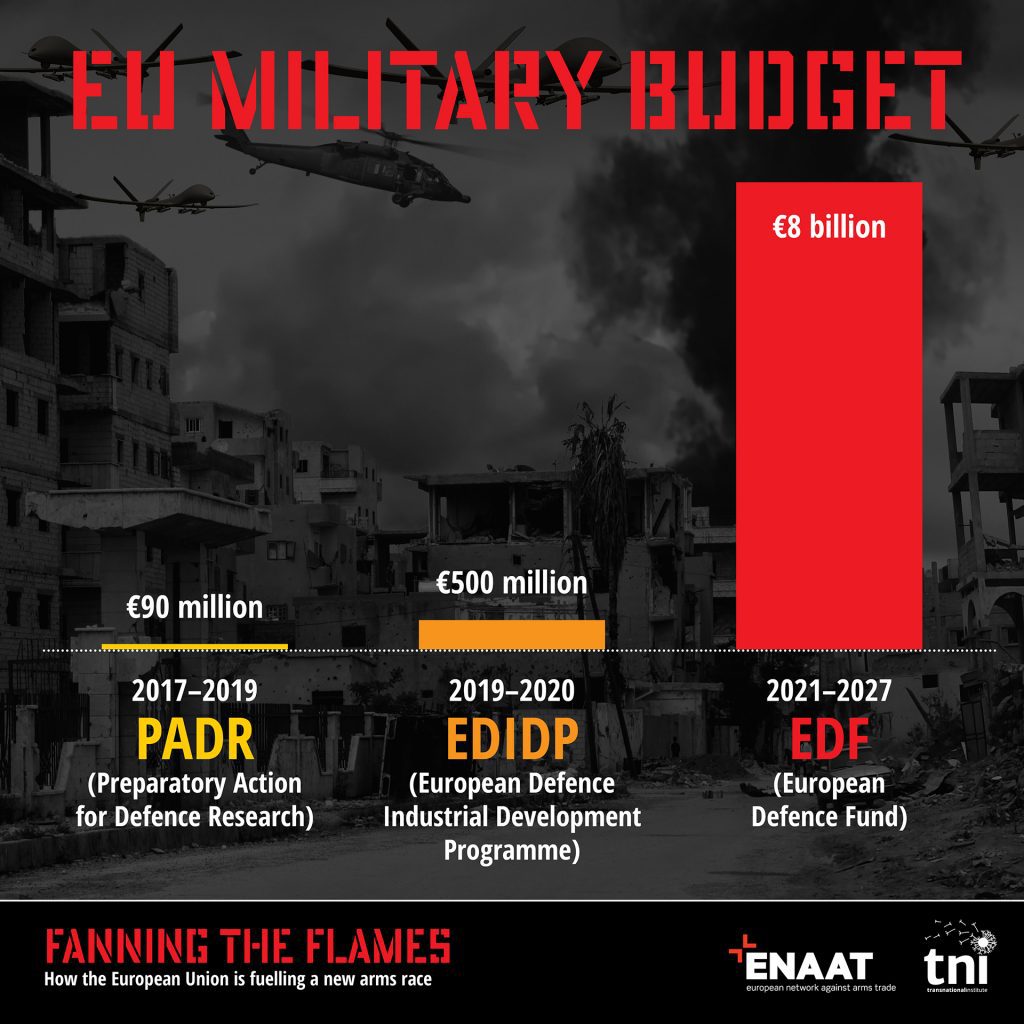
European Network Against the Arms Trade and Transnational Institute ‘Fanning the Flames’ March 2022
The initial precursor programmes got almost €600 million4 while the European Defence Fund (EDF) received an €8 billion budget. To date, the arms companies that directly influenced the creation of these funds have received €122 million or 28.1% of the current allocation, although this will undoubtedly rise once the entire budget is granted.5
In 2021, the EC approved the € 5.7 billion European Peace Facility (EPF),6 which, contrary to what its name suggests, finances EU military operations, such as those in West Africa or the Horn of Africa, as well as the provision of military equipment and training, with Ukraine being the first to receive such assistance. The fund is off-budget and therefore circumvents transparency, oversight and accountability procedures.
Research by Statewatch and the Transnational Institute found defence spending more than doubled from one budgetary cycle to the next, with €43.9 billion allocated for the 2021–2027 budget.7 By comparison, the amount allocated to the Citizens, Equality, Rights and Values Programme is just €1.4 billion. Arguably though, funding civilian peace initiatives would be much more conducive to building an enduring peace and align more closely with the EU’s founding principle of safeguarding it.
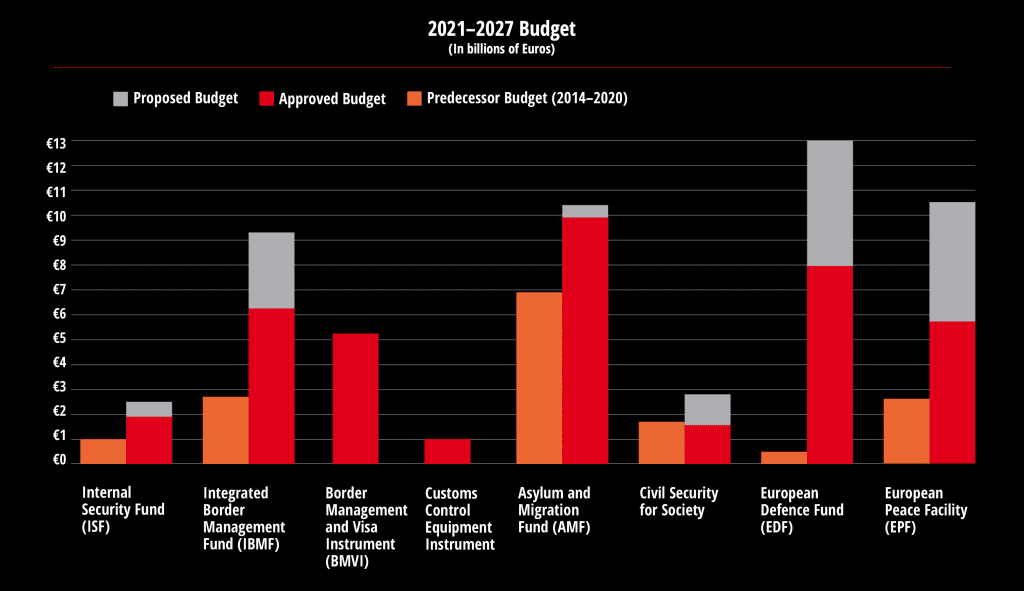
Statewatch and Transnational Institute ‘At What Cost?’ April 2022
Increased military spending is part of a worldwide trend, however. The Stockholm International Peace Research Institute (SIPRI) reported that the 2021 global military budget surpassed US$2.1 trillion for the first time.8 The US invested US$801 billion, while Europe’s top military spenders combined spent the equivalent of US$329.2 billion. China’s budget came in at US$293 billion, and Russia’s at US$65.8 billion. Although the EU’s €43.9 billion over a seven-year period may pale in comparison, the intended direction is clear and indicative of how the EU’s identity is shifting to include a growing military dimension to the union. This began long before the Ukraine war.
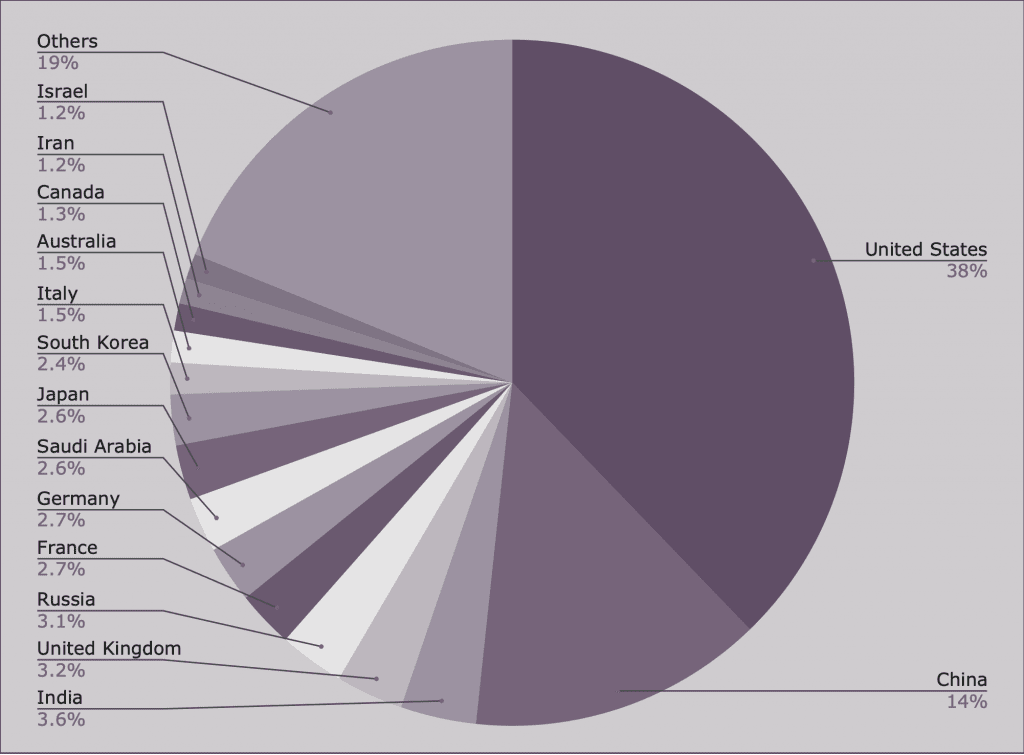
The share of world military expenditure of the 15 countries with the highest spending in 2021
Source: SIPRI Military Expenditure Database, Apr. 2022.
Since the invasion of Ukraine in February 2022, the EC has indicated that it intends to increase the EDF and EPF budget lines, as well as create a €500 million fund to incentivise joint arms procurement among member states to replenish military materiel sent to Ukraine.9 In the run-up to the June 2022 NATO Summit, European Council President, Charles Michel, announced an increase in military spending to an unprecedented €200 billion in the coming years.10
US and NATO in Europe
Since the end of the Cold War, and more aggressively since the so-called Global War on Terror (GWOT), there has been a growing obsession with preserving a unipolar world and US hegemony, to the detriment of global peace and stability. European nations have played their part in propping up the US at almost every turn.
In May 1990, then NATO Secretary General Manfred Worner said with regard to the former Soviet Union, ‘we have left behind us the old friend/foe mind-set and the confrontational outlook.’11 But, rather than abandoning divisive politics in the post-Cold War era and incorporating Russia in a pan-European democratised security structure based on diplomacy and cooperation, Western nations pursued a path of expansion. NATO expanded to incorporate 14 former Eastern bloc countries, a move which in 2007 President Putin described to be ‘a serious provocation that reduces the level of mutual trust’.12 A year later in 2008, NATO announced that its allies ‘welcomed Ukraine’s and Georgia’s Euro-Atlantic aspirations for membership and agreed that these countries will become members of NATO’.13
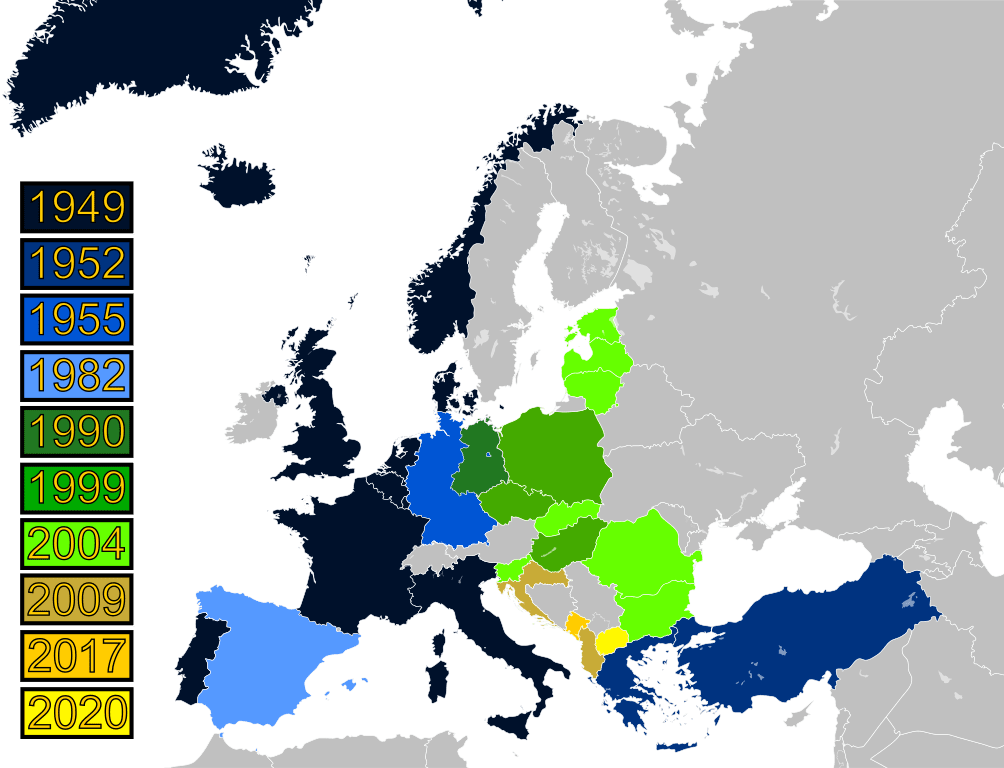
“History of NATO Expansion Map,” in World History Commons, https://worldhistorycommons.org/history-nato-expansion-map [accessed July 24, 2022]
In the years between Russia’s annexation of Crimea in 2014 and February 2022, the US provided over US$1.5 billion in military training and equipment to Ukraine, including sniper rifles, rocket-propelled grenade launchers, and counter-artillery radars.14
In early 2020, while campaigning for the US presidency, Joe Biden published an op-ed in Foreign Affairs titled ‘Why America Must Lead Again – Rescuing US Foreign Policy After Trump’. He wrote that under his leadership, the USA will once more lead the world, before arguing for sharper military capacity within NATO ‘to counter Russian aggression’.15
In June 2021, Ukraine hosted its largest-ever US-funded military drill, Operation Sea Breeze, involving 32 ships, 40 aircraft and helicopters, and 5,000 troops from 24 countries.16 In July, the Cossack Mace17 military exercises were held in Mykolayiv oblast (region) involving US, British, and Canadian troops, among others, while in September Ukraine led a US-assisted military training exercise in Yavoriv to enhance the inter-operability of US, NATO and Ukrainian troops.18
History has shown that an arms race is far more likely to lead to war than to prevent it. The naval race between Britain and Germany before the 1914–18 war is one such example. Although the responsibility for invading Ukraine lies squarely with Russia, the rhetoric, policies and arms provisions from the US and Europe to their eastern neighbour over the past decade have undoubtedly influenced the context in which the war began and now serve to prolong it.
Russia, militarism and the escalation before the war
Although in absolute terms Russia spends significantly less than the US (S$801 billion) and the combined sum spent by European nations (US$329.2 billion), its military expenditure (US$65.8 billion) has grown significantly over the past two decades, increasing by 175% between 2000 and 2019.19 Moreover, Russian military expenditure is estimated to be 4.3% of its GDP, which is higher than the 3.7% of GDP spent by the US.20 As early as April 2021 Russia began building up its military presence in the annexed territory of Crimea, and subsequently in Belarus and along its border with Ukraine, deploying large scale artillery, missiles and eventually fighter jets, as well as establishing military training camps and bases.21
In July 2021 President Putin published an article titled On the Historical Unity of Russians and Ukrainians in which he lays out his belief that ‘Russians and Ukrainians were one people – a single whole’ stating that ‘modern Ukraine is entirely a product of the Soviet era … shaped on the lands of historical Russia’.22
In November 2021, President Putin warned that ‘Russia will act if NATO crosses its red lines in Ukraine.23 But instead of taking steps to mitigate the risk of a Russian military attack, in January 2022 the US State Department did the opposite by clearing Baltic states Estonia, Latvia, and Lithuania, as well as the UK, to send high calibre US made missiles and other armament to Ukraine.24
Ukraine had become a tinderbox.
On 21 February 2022, President Putin took what he described as a ‘long overdue decision’ to recognise the independence and sovereignty of the People’s Republics of Donetsk and Luhansk.25 For Ukraine, this was a direct affront to its sovereignty and significantly heightened its fear of Russian imperialist aspirations being realised. The stage for war was set.
Strengthening military alliances
Before dawn on 24 February 2022 Russian tanks rolled in to Ukraine. The long looming war had begun. The EU’s shift from a being a political and economic alliance to also becoming a military one was cemented when EC President Ursula von der Leyen stood alongside NATO Secretary General Jens Stoltenberg and declared ‘we are one union, one alliance, united in purpose’.26
On 18 May, Finland and Sweden applied to join NATO,27 whose accession Secretary General Jens Stoltenberg claimed ‘… would make the Alliance stronger and the whole Euro-Atlantic area more secure’.28 In response President Putin stated that if military contingents and infrastructure is deployed to Finland or Sweden, Russia ‘would be obliged to respond symmetrically’.29
Both countries have a long history of military neutrality and remaining outside military alliances has served them well. Yet in a time of war they have abandoned a strategy that has brought them stability to join an alliance, the very expansion of which is a key factor that Russia has cited for its invasion of Ukraine.30 NATO member Turkey quickly announced that it would only accept their membership in exchange for the relaxation of arms embargoes and the extradition of persons alleged to be connected with the Kurdish struggle. Considering that Turkey exports arms to conflict zones, and has used similar trade-offs to justify waging war against the Kurds in the past, the knock-on effects of these Nordic nations joining NATO will be felt far beyond the geopolitical inner circles of the NATO alliance.31
In Denmark a referendum was passed in June with over a two-thirds majority to remove an exemption to it participating in the military dimension of the EU’s Common Security and Defence Policy.32
In all three countries this unprecedented embrace of militarism was ushered in by left-leaning Social Democratic Parties. Instead of upholding leftist principles of internationalism, social justice and equality, they have thrown their weight behind militarism, hierarchy, authority, and patriotism, concepts that are more broadly associated with right-wing politics and not conducive to building peace.
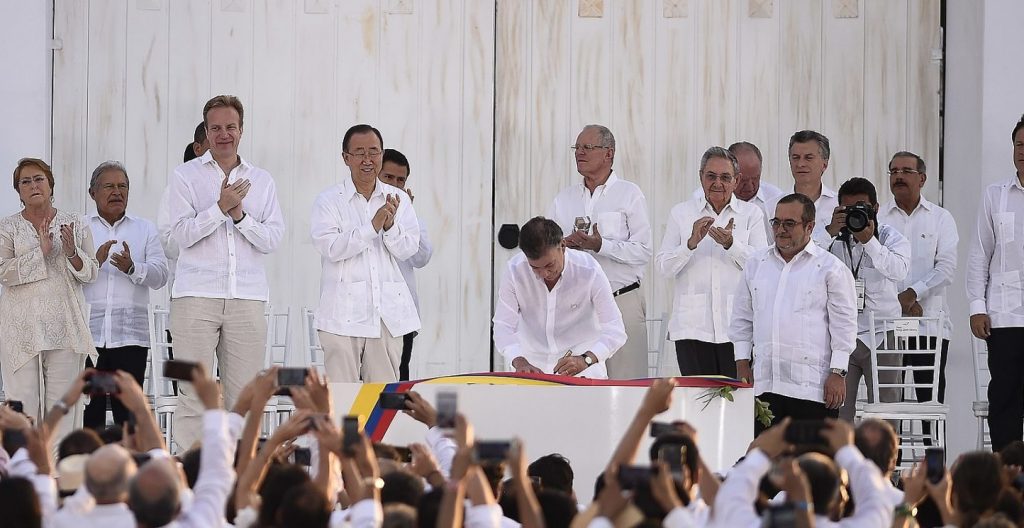
Colombia signs historic peace deal with Farc. Credit: Gobierno de Chile, CC BY 2.0 <https://creativecommons.org/licenses/by/2.0>, via Wikimedia Commons (Cropped)
Far too often, and increasingly with the war in Ukraine, military neutrality is misunderstood as a weak, passive, inactive stance, that permits and facilitates war while bringing nothing to conflict resolution. In fact, unaligned, militarily neutral nations have historically played a fundamental role in creating the conditions that give rise to a ceasefire, providing a neutral setting for peace negotiations to take place, accompanying these negotiations as a neutral mediator, and serving as a starting point from which the seeds of an enduring peace can be sown and political grievances can be resolved through diplomacy. Cuba, for example, played a crucial role in hosting and accompanying the peace talks between the Colombian government and the FARC-EP guerrilla group that culminated in the signing of a historic peace agreement in 2016.33 It is incumbent on states, particularly neutral nations, to use their position to actively engage and insist unapologetically that dialogue and diplomacy is the only way forward, rising above binary ‘with us or against us’ politics. Ireland, which has also experienced the fruits of a negotiated peace and currently sits on the UN Security Council, should lead by example in this regard.
Fuelling Weapons of War
Four days after the war began, EC President Ursula von der Leyen announced that ‘for the first time ever’, the EU would ‘finance the purchase and delivery of weapons… to a country that is under attack’.34
On the same day in Berlin, German Chancellor Olaf Scholz announced that the country’s defence budget would be increased to more than 2% of GDP and that €100bn would be invested in a one-time special fund for its armed forces. Although this was framed as a direct response to the invasion of Ukraine, it had, in fact, been on the cards since at least October 2021, when it was proposed by Germany’s Defence Minister. This represents Germany’s largest jump in military expenditure since World War II.35
For its part, long before the invasion, the Biden administration had begun increasing its military assistance to Ukraine, providing US$650 million during his first year in office. A further US$350 million weapons package was pledged in the days following the outbreak of war in February. Subsequently a bipartisan support package of US$13.5 billion was approved to ship materiel and humanitarian assistance to Ukraine, before a whopping US$ 40 billion was pledged, of which at least half is military assistance.36 In July an additional US$270 million security assistance package was announced.37 Thus far the US has pledged US$55 billion to Ukraine’s war effort. By comparison, it contributes just US$1.5 billion to the UN’s Global Peacekeeping Fund 2022 – 2023.38 Moreover, there are currently 100,000 US troops stationed in Europe, up from 85,000 already in place before the outbreak of war. This is highest number since the end of the Cold War and has steadily increased since 2014.39
As the war goes on, the US has called, not for de-escalation and a ceasefire, but for the protection of the sovereign nation of Ukraine and for Russia to be weakened.40 Having received such a vast array of military equipment and training from the West since well before the outbreak of the current war, it is questionable to what extent Ukraine, or any other nation for that matter, that serves the agenda of US hegemony and benefits materially from it, remains truly sovereign.
Arms companies – the winners in war
While NATO member states have not deployed troops to Ukraine, they have provided artillery, anti-aircraft and anti-tank weapons, armoured vehicles, reconnaissance and attack drones, helicopters, smalls arms including rifles, pistols and machine guns, ammunition, body armour and helmets.41 The US has also provided intelligence assistance with aircraft designed for this purpose positioned over Poland, Romania and the Black Sea.42
Since the invasion arms companies’ profits have soared. Between 23 February and 8 June, the share prices of Lockheed Martin rose by 14%, Northrop Grumman by 22.3%, BAE Systems by 31.9%, Thales by 39.4%, Leonardo by 67.8% and Rheinmetall by a colossal 123.9%.43 Within this context, states have published extensive shopping lists of sophisticated armaments that they plan to purchase in the coming years to replenish their armed forces.
Coupled with that, the EU intends to relax the criteria for arms exports44 and the European Defence Agency has begun promoting the notion that the arms industry is sustainable, boasting that ‘defence is going green’.45 There is a complete disconnect between the death, devastation, and destruction caused by the use of armaments, and the narratives peddled to justify their development, export, and use. This is even more perverse given that so many of the policies that permit the expanse of the arms industry are made precisely by those who will benefit directly from them.
At least 20 US federal legislators or their partners hold stocks in Raytheon Technologies and Lockheed Martin,46 while in the UK, Tory peers Lord Glendonbrook, Viscount Eccles and Lord Sassoon, and unaffiliated peers Lord Lupton and Lord Gadhia, each own shares of at least £50,000 in BAE Systems.47 While legislators are not prohibited from sitting on committees, writing legislation, or voting on bills that might affect them financially, the optics might suggest otherwise. The fact that those in positions of power benefit hugely from militarism is a point that is often missed when analysing the structural drivers of war.
Ukraine has been devastated by this war. In its most recent update from 25 July, the United Nations Office for the High Commissioner for Human Rights reported that 5,237 civilians had been killed and a further 7,035 injured.48 The United Nations High Commissioner for Refugees (UNHCR) reported that one in three Ukrainian citizens has been displaced, seven million within the country,49and a further 5.5 million have sought refuge elsewhere in Europe.50 In the city of Mariupol, which saw some of the worst fighting, the UN estimated that up to 90% of residential buildings and 60% of homes have been destroyed.51 Across the country infrastructure – such as bridges, roads, railways, hospitals and schools – have been targeted and destroyed. According to Ukrainian Prime Minister Denys Shmyhal, the cost of reconstruction is already set to reach $750bn.52
The effects of the war have been felt way beyond Ukraine. According to António Guterres, the UN Secretary General, the world will face severe food shortages with many countries expected to experience food insecurity and even famine as a result of the war being added to existing pressures.53 Similarly, with very few exceptions, governments are forcing consumers to cough up for rising energy bills related to fuel insecurity caused by the war, as opposed to addressing massive corporate profits. This will severely affect those who are already economically vulnerable and push many into poverty.
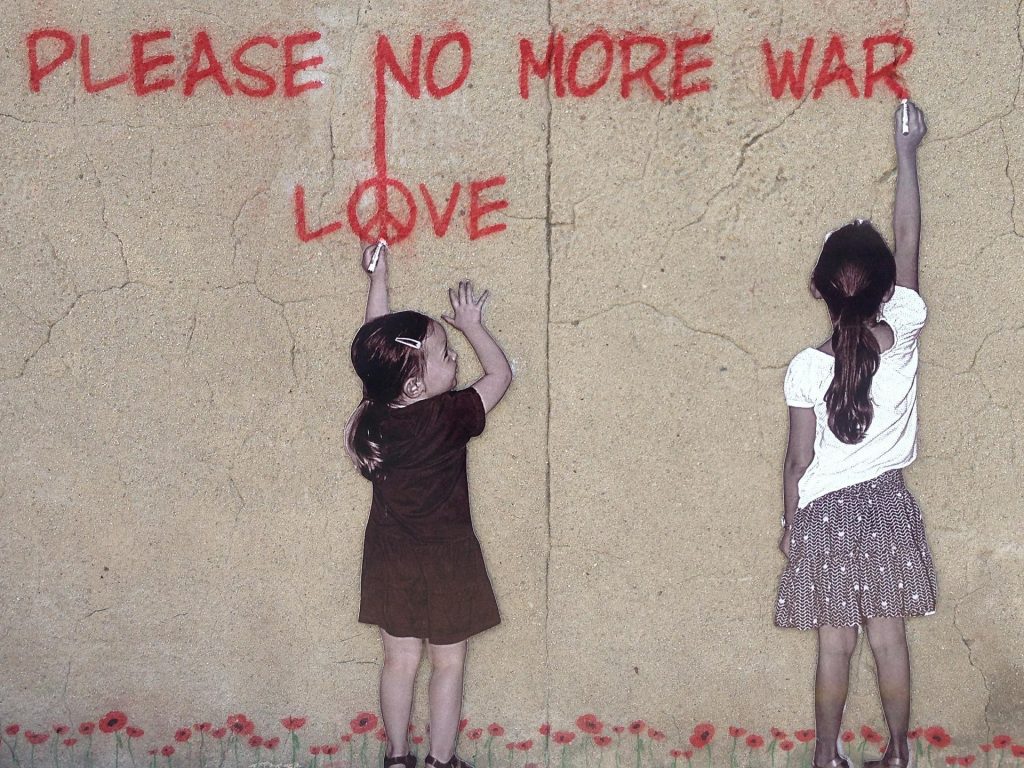
Annette Jones/Pixabay License
There is no long-term strategy or ultimate goal beyond militarise by any and all possible means. At a national level, money that could be spent on strengthening access to health, education, social care and other essential services, is instead invested in military expenditure. Globally, resources that could be invested to offset the excessive warming of our planet and the destruction of ecosystems, to guarantee universal access to water and food security, or to prevent conflict and build peace, is used to guarantee the security of the few to the detriment of the many. This is madness. Recalling the global sum of US$2.1 trillion on military spending, what would our world look like if there was a committed collective effort to invest in peace, not war?
However dire things are now, they will undoubtedly get significantly worse if the threat of nuclear warfare is realised. Currently the US and Russia hold the highest number of nuclear warheads, with the US arsenal also dispersed around Europe.54 Moreover, other nuclear powers such as India, Israel, or Pakistan, may be emboldened to flex their nuclear muscles in their own ongoing conflicts were Russia to make good its threat of doing so first. The consequences of nuclear warfare are terrifying and yet if this war continues, it may eventually culminate in exactly that. If for no other reason, global leaders must urgently shift course in favour of dialogue, diplomacy and peace. The stakes of doing otherwise are too high.
Notes
1 Schuman Declaration 1950 https://european-union.europa.eu/principles-countries-history/history-eu/1945-59/schuman-declaration-may-1950_en
2 Lisbon Treaty 2007 https://eur-lex.europa.eu/legal-content/EN/TXT/?uri=CELEX%3A12007L%2FTXT
3 Group of Personalities press statement lists its members: https://eda.europa.eu/news-and-events/news/2015/06/18/high-level-group-of-personalities-on-defence-research-issues-statement
4 EU precursor programmes – PADR and EDIDP https://ec.europa.eu/commission/presscorner/detail/es/qanda_20_1052
5 The figures featured in ENAAT and TNI’s Fanning the Flames report date from March 2022 and show that the companies in question received €86 million or 30.7%. https://www.tni.org/en/publication/fanning-the-flames The figures in this article date from July 2022. These have been updated from the PADR and EDIDP websites by reviewing the awarded projects.
6 Website of the European Peace Facility: https://www.consilium.europa.eu/en/policies/european-peace-facility/
7 Statewatch and Transnational Institute ‘At What Cost?’ April 2022: https://eubudgets.tni.org/
8 https://sipri.org/media/press-release/2022/world-military-expenditure-passes-2-trillion-first-time
9 https://ec.europa.eu/commission/presscorner/detail/en/statement_22_3391
10 https://www.consilium.europa.eu/en/press/press-releases/2022/06/29/remarks-by-president-charles-michel-before-the-nato-summit-in-madrid/
11 NATO Archive May 1990 https://www.nato.int/docu/speech/1990/s900517a_e.htm
12 Entire speech given by President Putin: https://russialist.org/transcript-putin-speech-and-the-following-discussion-at-the-munich-conference-on-security-policy/
13 NATO Archive April 2008 Bucharest Summit https://www.nato.int/docu/update/2008/04-april/e0403h.html
14 US Department of Defence press release June 2019 https://www.defense.gov/News/Releases/Release/Article/1879340/dod-announces-250m-to-ukraine/
15 https://www.foreignaffairs.com/articles/united-states/2020-01-23/why-america-must-lead-again
16 https://www.dw.com/en/sea-breeze-ukraine-us-black-sea-drills-raise-tensions-with-russia/a-58081985 and https://seapowermagazine.org/exercise-sea-breeze-2021-comes-to-a-close-in-black-sea/
17 https://www.osce.org/files/f/documents/5/a/493255.pdf
18 https://www.army.mil/article/250444/us_nato_ukraine_enhance_interoperability_with_rapid_trident_exercise
19 https://www.sipri.org/commentary/topical-backgrounder/2020/russias-military-spending-frequently-asked-questions
20 https://data.worldbank.org/indicator/MS.MIL.XPND.GD.ZS?locations=RU-US
21 https://www.youtube.com/watch?v=7Hu5FErz1js
22 http://en.kremlin.ru/events/president/news/66181
23 https://www.reuters.com/markets/stocks/putin-warns-russia-will-act-if-nato-crosses-its-red-lines-ukraine-2021-11-30/
24 https://www.reuters.com/world/europe/us-clears-baltic-states-send-us-made-weapons-ukraine-2022-01-20/
25 http://en.kremlin.ru/events/president/news/67828
26 Statement by EC President von der Leyen: https://ec.europa.eu/commission/presscorner/detail/en/statement_22_1332
27 NATO Press release https://www.nato.int/cps/en/natohq/news_195468.htm
28 NATO Press Statement on Finland – Sweden – Turkey talks: https://www.nato.int/cps/en/natohq/news_196935.htm
29 https://www.theguardian.com/world/2022/jun/29/russia-condemns-nato-invitation-finland-sweden
30 https://tomdispatch.com/would-a-cold-war-be-the-best-news-around/
31 https://www.theguardian.com/world/2022/jun/28/turkey-lifts-objections-to-finland-and-swedens-nato-bid
32 https://www.bbc.com/news/world-europe-61644663
33 https://www.ipinst.org/wp-content/uploads/2017/02/IPI-Rpt-Made-in-Havana.pdf
34 https://ec.europa.eu/commission/presscorner/detail/en/statement_22_1441
35 https://www.opendemocracy.net/en/oureconomy/ukraine-war-russia-germany-defence-military-lobbying/
36 https://www.cnbc.com/2022/05/21/biden-signs-40-billion-aid-package-for-ukraine-during-trip-to-asia.html
37 https://www.defense.gov/News/Releases/Release/Article/3102984/270-million-in-additional-security-assistance-for-ukraine/
38 https://press.un.org/en/2022/gaab4386.doc.htm
39 https://theintercept.com/2022/03/10/ukraine-russia-nato-weapons/
40 https://www.washingtonpost.com/world/2022/04/25/russia-weakened-lloyd-austin-ukraine-visit/
41 https://www.aljazeera.com/news/2022/6/15/infographic-what-weapons-has-ukraine-received-from-the-us-and-al
42 https://theintercept.com/2022/03/17/us-intelligence-ukraine-russia/
43 https://news.sky.com/story/ukraine-war-how-weapons-makers-are-profiting-from-the-conflict-12624574
44 https://ec.europa.eu/commission/presscorner/detail/en/ip_22_924
45 https://eda.europa.eu/news-and-events/news/2022/05/25/discover-how-defence-is-going-green
46 https://www.businessinsider.com/congress-war-profiteers-stock-lockheed-martin-raytheon-investment-2022-3?international=true&r=US&IR=T
47 https://www.opendemocracy.net/en/dark-money-investigations/ukraine-war-uk-lords-richer-arms-investments-russia-bae-systems/?source=in-article-related-story
48 https://www.ohchr.org/en/press-releases/2022/07/ukraine-civilian-casualty-update-25-july-2022
49 https://www.unhcr.org/ua/en/internally-displaced-persons
50 https://data.unhcr.org/en/situations/ukraine
51 https://www.ohchr.org/en/statements/2022/06/high-commissioner-updates-human-rights-council-mariupol-ukraine
52 https://www.aljazeera.com/news/2022/7/4/ukraine-russia-live-news-six-killed-in-eastern-town-sloviansk
53 https://www.bbc.com/news/world-europe-61503049
54 https://www.sipri.org/media/press-release/2022/global-nuclear-arsenals-are-expected-grow-states-continue-modernize-new-sipri-yearbook-out-now
Photo credit
Image 1.
Credit: Image by Wendelin Jacober on Pixabay
Image 2.
Credit: Image by Christian Lue on Unsplash
Image 3:
Credit: European Network Against the Arms Trade and Transnational Institute ‘Fanning the Flames’ March 2022
Image 4:
Credit: Statewatch and Transnational Institute ‘At What Cost?’ April 2022 https://eubudgets.tni.org/
Image 5:
The share of world military expenditure of the 15 countries with the highest spending in 2021
SIPRI Trends in World Miltiary Expenditure 2021
https://www.sipri.org/sites/default/files/2022-04/fs_2204_milex_2021_0.pdf
Image 6:
NATO and US flags
Credit: NATO North Atlantic Treaty Organization, CC BY-NC-ND 2.0, on Flickr
Image 7:
Credit: “History of NATO Expansion Map,” in World History Commons, https://worldhistorycommons.org/history-nato-expansion-map [accessed July 24, 2022]
Image 8:
Credit: Image by Evgeni Tcherkasski on Pixabay
Image 9:
Credit: Stockholm International Peace Research Institute ( SIPRI ), Yearbook: Armaments, Disarmament and International Security
https://data.worldbank.org/indicator/MS.MIL.XPND.GD.ZS?locations=RU-US
Image 10
Credit: Image by Amber Clay on Pixabay
Image 11
Credit: Gobierno de Chile, CC BY 2.0 <https://creativecommons.org/licenses/by/2.0>, via Wikimedia Commons
Image 12
Credit: Image by Military Material on Pixabay
Image 13
Credit: 3D Animation Production Company on Pixabay
Image 14
Credit: Image by Peter H on Pixabay
Image 15
Credit: Image by Annette Jones on Pixabay
Teaser photo credit: Wendelin Jacober/Pixabay License





